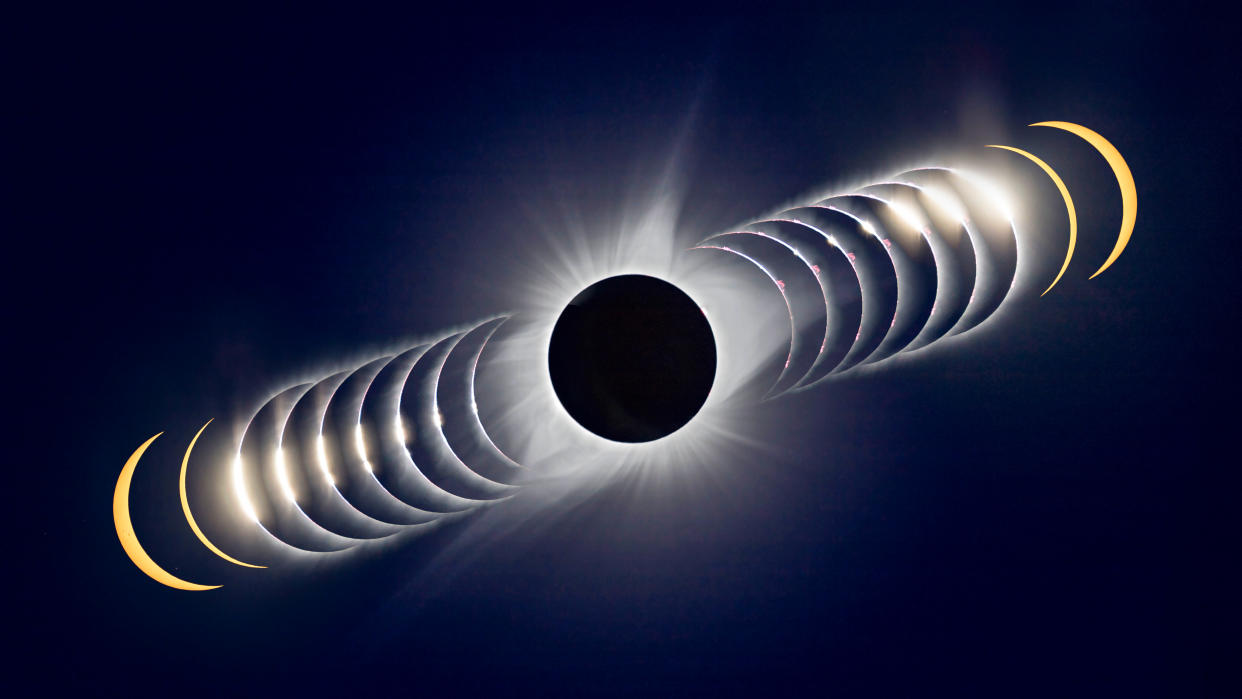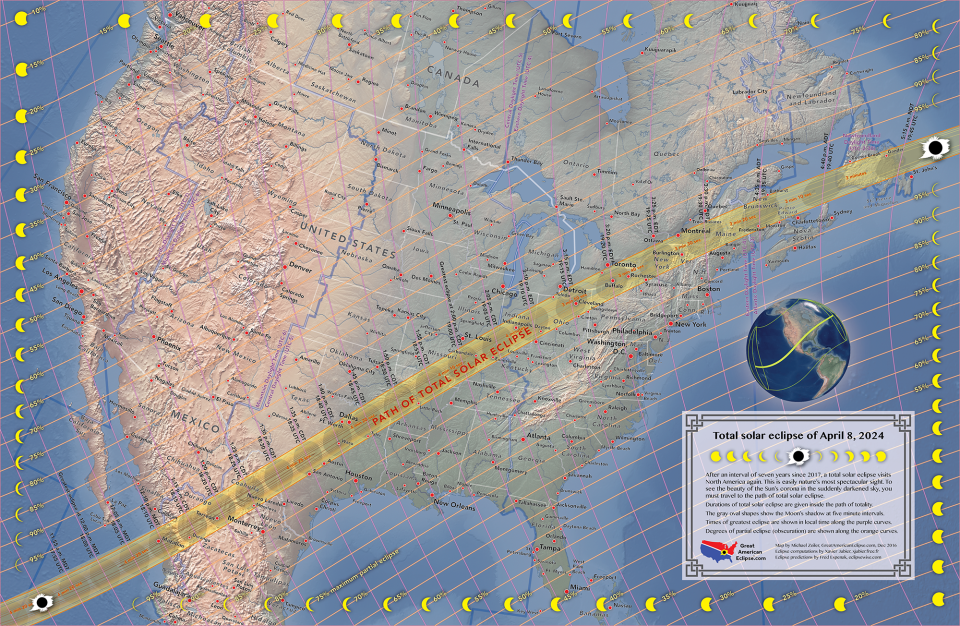Get set to photograph 2024's Great North American Solar Eclipse next week

Capturing the precious moments at the peak of a total solar eclipse is on the bucket list of most photographers, let alone astrophotographers – an on Monday millions of North Americans have the chance of seeing this amazing cosmic event. Lasting just a few minutes, totality is when the moon moves across the sun to perfectly block its light, exposing the latter’s tenuous, textured outer atmosphere called the solar corona.
On April 8, 2024, one of the longest totalities in over a decade will be visible from within a 120-mile-wide, 10,000-mile-long path of totality stretching from the Pacific coast of Mexico to the Atlantic coast of Canada via 15 US states. Meanwhile, the whole of North America will experience a partial solar eclipse. It’s going to be a massive event.
What’s unusual about this solar eclipse
This will be the second total solar eclipse in the US since August 21, 2017, an event nicknamed the ‘Great American Eclipse’. However, totality during that event lasted 2 minutes 40 seconds but on April 8, 2024, the maximum duration is a whopping 4 minutes 27 seconds – plenty of time for photography!
It will be the longest land-based totality anywhere on Earth since July 11, 2010, which was visible on Easter Island. It will also be Mexico’s first total solar eclipse since July 11, 1991, and Canada’s first since February 26, 1979.
There are a few other quirks. Pick any spot on Earth’s surface and, on average, it will experience a total eclipse of the sun every 375 years. However, on April 8, 2024, residents of part of Illinois, Missouri and Kentucky will experience their second totality in 6 years, 7 months, and 18 days.

You need to make a plan now
It’s thought that 32 million people live inside the path of totality. That’s 20 million more than in 2017. Furthermore, since Boston, New York, Philadelphia, Baltimore, and Washington DC are all within 200 miles of the path of totality, there could be a last-minute surge. Expect huge crowds.
The closer you stand to the center of the path of totality the longer the duration of totality. Click within this interactive Google Map to see the circumstances for specific locations.
How to plan a trip to shoot the eclipse
There are three major factors in choosing where to be to photograph any total solar eclipse. Here’s what you need to think about:
Attending large spectator gatherings such as Lowell Observatory’s Eclipse Over Texas event at McLane Stadium in Waco, Texas, or at the NASA-sponsored event at the Indianapolis Motor Speedway will be excellent for crowd shots and people’s reactions, but they may be a mistake if you intend to set up a camera/cameras on tripods. You might find roped-off areas at such events that make it relatively easy, but it’s never guaranteed. Besides, even if there’s less chance of your tripod being kicked it’s unlikely you’ll find a good foreground at big events for context shots.
Although it’s tempting to zoom in on totality with a 600mm lens, the more interesting and memorable shots tend to feature the weird-looking mid-totality sky and a totally eclipsed sun around an interesting foreground subject.
Previous examples include a dinosaur, an observatory and a scheduled flight. Scouting-out good locations with unusual or interesting foregrounds ahead of time is a good idea, but don’t forget to have a shortlist rather than a favored location because by far the most important factor is the weather. A cloudy sky during the eclipse will render this a non-event, photographically-speaking. Yes, it will get dark – actually much darker under clouds than if the sky is clear – but you won’t get to photograph the eclipsed sun.
Suggested observing locations

Note that if you want only to capture close-ups of the solar corona it matters not where you observe from – you just need clear skies – which some of these locations are ideal for. However, if you want to be somewhere special to attempt wide-angle images with a sense of place then you’ll also find some tempting locations:
1. Mazatlán, Sinaloa, Mexico
Totality from this seaside town – complete with a historic district and the highest lighthouse in the Americas – occurs at 11:07 am MST for 4 minutes 20 seconds with the sun 69º above the southeast horizon.
2. Torreón, Coahuila, Mexico
Totality from this large city on the arid Mexican Plateau occurs at 12:16 pm MST for 4 minutes 9 seconds with the sun 70º above the south-southeast horizon.
3. Fredericksburg, Texas
Totality from the most famous Texas Hill Country town occurs at 1:32 pm CDT with the sun 67º above the southern horizon for 4 minutes 25 seconds. The town is getting organized for the influx.
4. Dallas, Texas
Totality from this city of skyscrapers and 1.3 million people occurs at 1:40 pm CDT with the sun 65º above the southern horizon for 3 minutes 52 seconds.
5. Beavers Bend State Park, Oklahoma
Totality from this, one of seven state parks in Oklahoma in the path of totality, occurs at 1:44 pm CDT 63º with the sun above the south-southwest horizon for 4 minutes 13 seconds.
6. Hot Springs National Park, Arkansas
Totality from these ancient thermal springs occurs at 1:49 pm CDT with the sun 62º above the south-southwest horizon for 3 minutes 38 seconds. An event is being organized.
7. Cape Girardeau, Missouri
Totality from this historic town occurs at 1:58 pm CDT with the sun 57.5º above the south-southwest horizon for 4 minutes 7 seconds.
8. Southern Illinois University, Carbondale, Illinois
Totality from the Southern Illinois Crossroads Eclipse Festival occurs at 1:59 pm CDT 57º above the south-southwest horizon for 4 minutes 9 seconds.
9. Niagara Falls, Canada
Totality from the Niagara River’s western shore (overlooking Horseshoe Fall) occurs at 3:18 pm EDT with the sun 46º above the southwest horizon for 3 minutes 31 seconds.
10. Mont Mégantic Observatory, Sherbrooke, Quebec, Canada
Totality at this astronomical observatory occurs at 3:28 pm EDT 38.5º above the west-southwest horizon for 3 minutes 28 seconds. An event is being planned.
Stay safe and buy protection
You will need special glasses to view a solar eclipse - so order these in advance. Solar eclipse binoculars can also be bought to give you a closer view. If you want to photograph the event, you will need to get a solar eclipse filter - an especially dark ND filter.
Here are some of the options for these:
When is the next total solar eclipse after 2024?
The next total solar eclipse will occur on 12 August 2026 across Greenland, Iceland and northern Spain. Europe’s first totality since 1999, observing locations will include the Snæfellsnes Peninsula and Reykjavik in Iceland and León, Burgos and Zaragoza in Spain. From Mallorca in the Balearic Islands, an eclipsed sunset will be visible. The maximum duration of totality will be 2 minutes and 18 seconds off the coast of Iceland. The British Isles will see a substantial partial solar eclipse, with Dursey Island in Eire seeing a 97.88% partial eclipse while Belfast and Cardiff (93%), London (91%) and Edinburgh (90%).
All timings are from timeanddate.com. Exact timings for specific points on the map are available on Xavier Jubier’s interactive Google Map.

